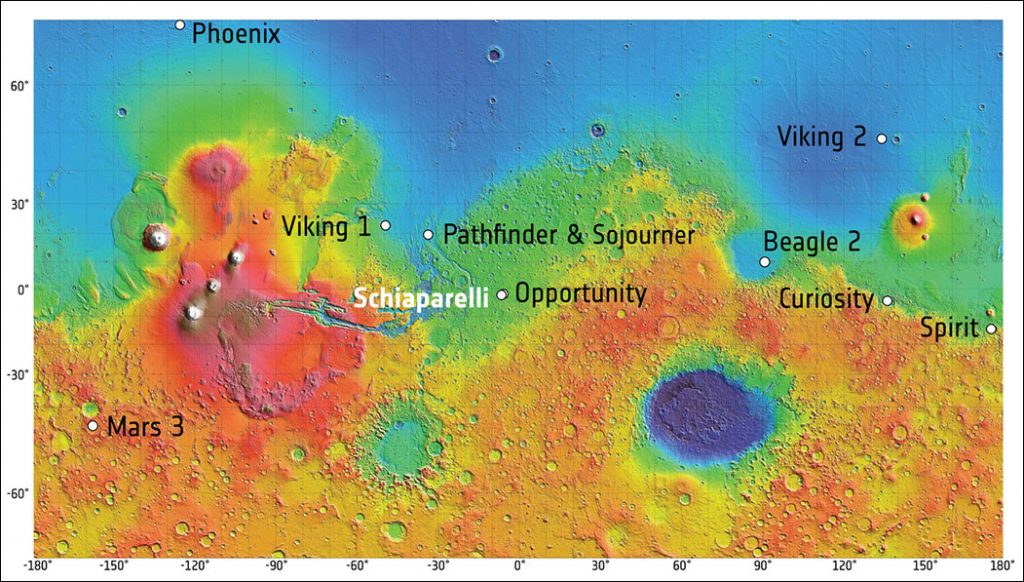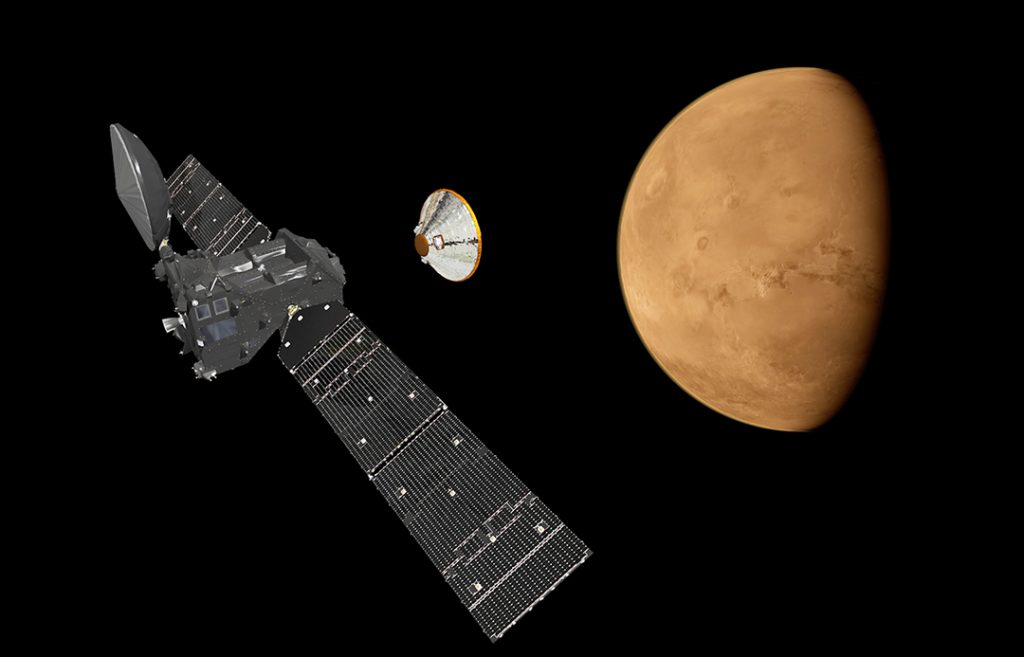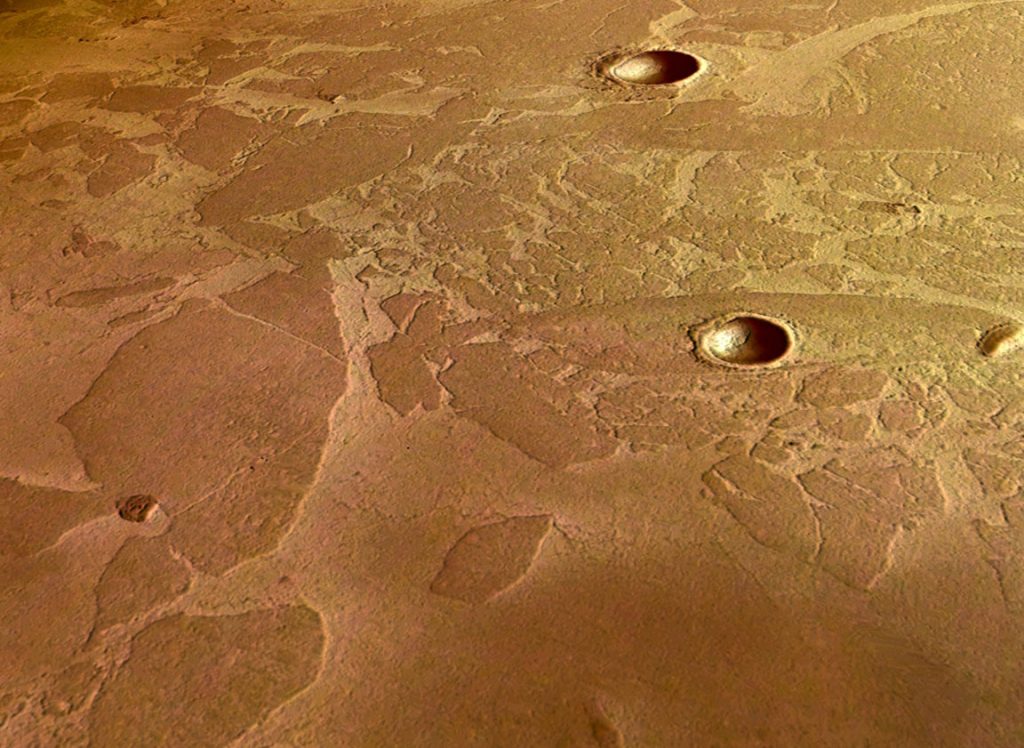Watch how Schiaparelli will land on Mars. Touchdown will occur at 10:48 a.m. EDT (14:48 GMT) Wednesday Oct. 19.
Cross your fingers for good weather on the Red Planet on October 19. That’s the day the European Space Agency’s Schiaparelli lander pops open its parachute, fires nine, liquid-fueled thrusters and descends to the surface of Mars. Assuming fair weather, the lander should settle down safely on the wide-open plains of Meridiani Planum near the Martian equator northwest of NASA’s Opportunity rover. The region is rich in hematite, an iron-rich mineral associated with hot springs here on Earth.

The 8-foot-wide probe will be released three days earlier from the Trace Gas Orbiter (TGO) and coast toward Mars before entering its atmosphere at 13,000 mph (21,000 km/hr). During the 6-minute-long descent, Schiaparelli will decelerate gradually using the atmosphere to brake its speed, a technique called aerobraking. Not only is Meridiani Planum flat, it’s low, which means the atmosphere is thick enough to allow Schiaparelli’s heat shield to reduce its speed sufficiently so the chute can be safely deployed. The final firing of its thrusters will ensure a soft and controlled landing.

The lander is one-half of the ExoMars 2016 mission, a joint venture between the European Space Agency and Russia’s Roscosmos. The Trace Gas Orbiter (TGO) will fire its thrusters to place itself in orbit about the Red Planet the same day Schiparelli lands. Its job is to inventory the atmosphere in search of organic molecules, methane in particular. Plumes of methane, which may be biological or geological (or both) in origin, have recently been detected at several locations on Mars including Syrtis Major, the planet’s most prominent dark marking. The orbiter will hopefully pinpoint the source(s) as well as study seasonal changes in locations and concentrations.

Methane (CH4) has long been associated with life here on Earth. More than 90% of the colorless, odorless gas is produced by living organisms, primarily bacteria. Sunlight breaks methane down into other gases over a span of about 300 years. Because the gas relatively short-lived, seeing it on Mars implies an active, current source. There may be several:
- Long-extinct bacteria that released methane that became trapped in ice or minerals in the upper crust. Changing temperature and pressure could stress the ice and release that ancient gas into today’s atmosphere.
- Bacteria that are actively producing methane to this day.
- Abiological sources. Iron can combine with oxygen in terrestrial hot springs and volcanoes to create methane. This gas can also become trapped in solid forms of water or ‘cages’ called clathrate hydrates that can preserve it for a long time. Olivine, a common mineral on Earth and Mars, can react with water under the right conditions to form another mineral called serpentine. When altered by heat, water and pressure, such in environments such as hydrothermal springs, serpentine can produce methane.
Will it turn out to be burping bacteria or mineral processes? Let’s hope TGO can point the way.

The Trace Gas Orbiter will also use the Martian atmosphere to slow its speed and trim its orbital loop into a 248-mile-high (400 km) circle suitable for science observations. But don’t expect much in the way of scientific results right away; aerobraking maneuvers will take about a year, so TGO’s job of teasing out atmospheric ingredients won’t begin until December 2017. The study runs for 5 years.
The orbiter will also examine Martian water vapor, nitrogen oxides and other organics with far greater accuracy than any previous probe as well as monitor seasonal changes in the atmosphere’s composition and temperature. And get this — its instruments can map subsurface hydrogen, a key ingredient in both water and methane, down to a depth of a meter (39.4 inches) with greater resolution compared to previous studies. Who knows? We may discover hidden ice deposits or methane sinks that could influence where future rovers will land. Additional missions to Mars are already on the docket, including ExoMars 2020. More about that in a minute.

While TGO’s mission will require years, the lander is expected to survive for only four Martian days (called ‘sols’) by using the excess energy capacity of its batteries. A set of scientific sensors will measure wind speed and direction, humidity, pressure and electric fields on the surface. A descent camera will take pictures of the landing site on the way down; we’ll should see those photos the very next day. Data and imagery from the lander will be transmitted to ESA’s Mars Express and a NASA Relay Orbiter, then relayed to Earth.
This animation shows the paths of the Trace Gas Orbiter and Schiaparelli lander on Oct. 19 when they arrive at Mars.
If you’re wondering why the lander’s mission is so brief, it’s because Schiaparelli is essentially a test vehicle. Its primary purpose is to test technologies for landing on Mars including the special materials used for protection against the heat of entry, a parachute system, a Doppler radar device for measuring altitude and liquid-fueled braking thrusters.
Martian dust storms can be cause for concern during any landing attempt. Since it’s now autumn in the planet’s northern hemisphere, a time when storms are common, there’s been some finger-nail biting of late. The good news is that storms of recent weeks have calmed and Mars has entered a welcome quiet spell.
To watch events unfold in real time, check out ESA’s live stream channel, Facebook page and Twitter updates. The announcement of the separation of the lander from the orbiter will be made around 11 a.m. Eastern Time (15:00 GMT) Sunday October 16. Live coverage of the Trace Gas Orbiter arrival and Schiaparelli landing on Mars runs from 9-11:15 a.m. Eastern (13:00-15:15 GMT) on Wednesday October 19. Photos taken by Schiaparelli’s descent camera will be available starting at 4 a.m. Eastern (8:00 GMT) on October 20. More details here. We’ll also keep you updated on Universe Today.

Everything we learn during the current mission will be applied to planning and executing the next — ExoMars 2020, slated to launch in 2020. That venture will send a rover to the surface to search and chemically test for signs of life, present or past. It will collect samples with a drill at various depths and analyze the fines for bio-molecules. Getting down deep is important because the planet’s thin atmosphere lets through harsh UV light from the sun, sterilizing the surface.
Are you ready for adventure? See you on Mars (vicariously)!


The European Space Agency is doing some interesting projects. The newest photos of Mars will be interesting.
Am a bit surprised that the Shiaparelli lander doesn’t have landing legs, almost as surprised as when I saw that Phillae came equipped with ‘harpoons’ to stab into Comet Chury-Gary to anchor it down.
Both of these ideas make certain assumptions about the landing area’s regolith and surface conditions. For Phillae, obviously the surface was much harder than assumed? Either that or the landing induced gravitational reflex underestimated? In Shiaparelli’s case, the designers have assumed they will land on a fairly flat and level surface? Apparently they know that no boulders or steep slopes are in the LZ. Lets hope they hit the spot dead on and factors like atmospheric dust content or dust bowls on the surface cooperate!
Aqua, I’ll have to look this up, but I wonder if the descent camera can clue the lander to avoid large boulders.
The MER-B Opportunity rover traversed the area a few years ago on its way to Endeavour crater, only a dozen km away from the middle of the landing ellipse.
The only rocks that stood out in this flat plain were meteorites.
Also the Shiaparelli lander is designed to use its final inertia and its posterior conical shape after retro-rockets shut down to bury itself up to its “waist”
After the lander’s batteries are drained once the 4 days (Sols) mission is over, it’ll be a great target of “Opportunity” for MER-B once it is done exploring the western rim of Endeavour… assuming it survives the upcoming dust storms and another Mars winter 🙂
Thank you Astrobob! I love oblique views like that pic from Mars Express.
Crocodile – me too! One of the coolest orbiters up there and generally underappreciated.